Tesco's Business Environment: Macro Factors and SWOT Analysis Report
VerifiedAdded on 2020/09/08
|10
|2626
|158
Report
AI Summary
This report provides a comprehensive analysis of Tesco's business environment, focusing on the impact of macro environmental factors and a detailed SWOT analysis. It explores the political, economic, social, technological, legal, and environmental (PESTLE) factors affecting Tesco's operations, particularly in the UK and emerging markets like India and China. The report identifies Tesco's strengths, such as its skilled workforce, brand value, and technological adoption, while also addressing weaknesses like its reliance on the domestic market and low profit margins. Opportunities in organic food sales and expansion in Asian markets are discussed, alongside threats from global competitors and economic uncertainties. The analysis further connects these strengths and weaknesses with external factors, highlighting how political events, economic conditions, and technological advancements influence Tesco's performance and strategic decisions. The report concludes with a summary of key findings and implications for Tesco's future strategies.
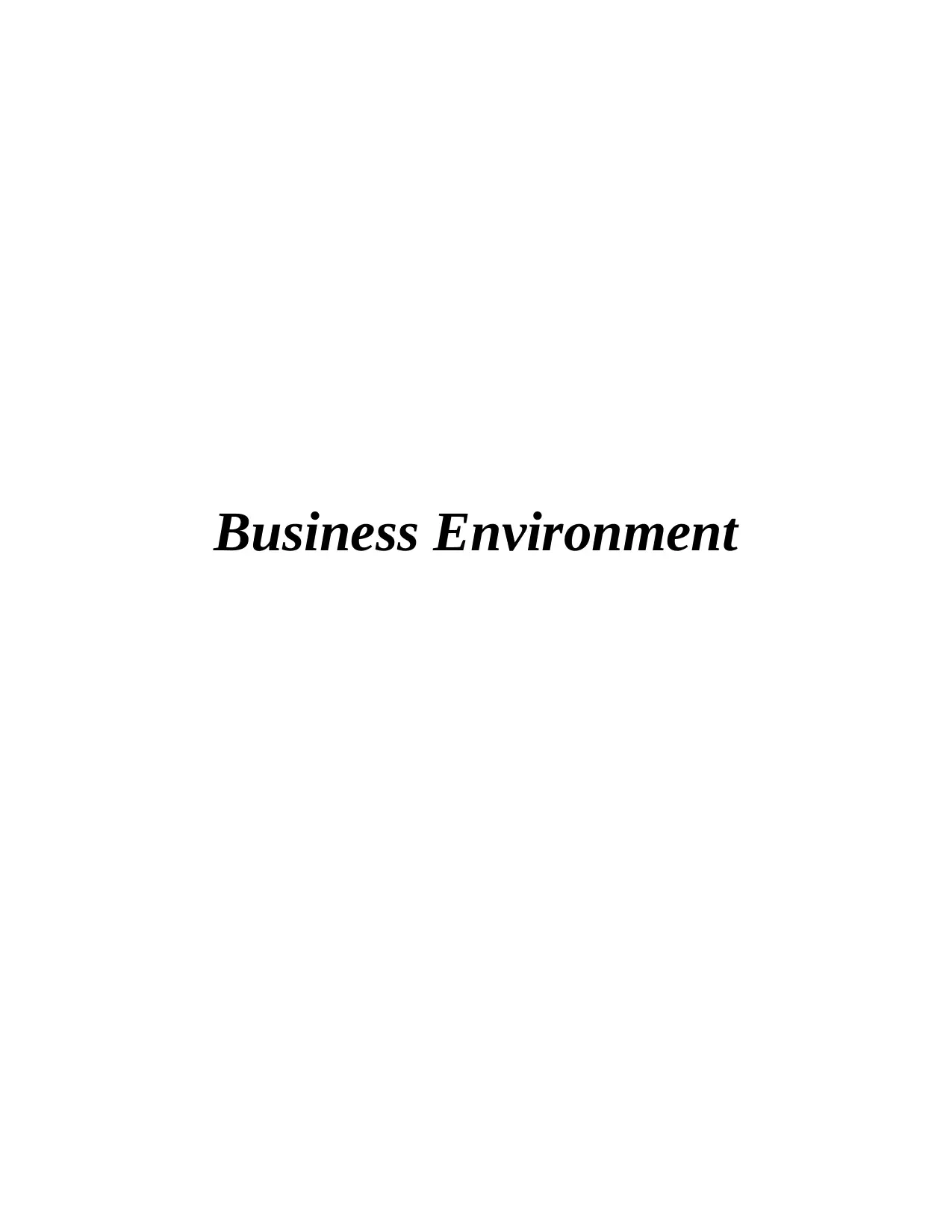
Business Environment
Paraphrase This Document
Need a fresh take? Get an instant paraphrase of this document with our AI Paraphraser
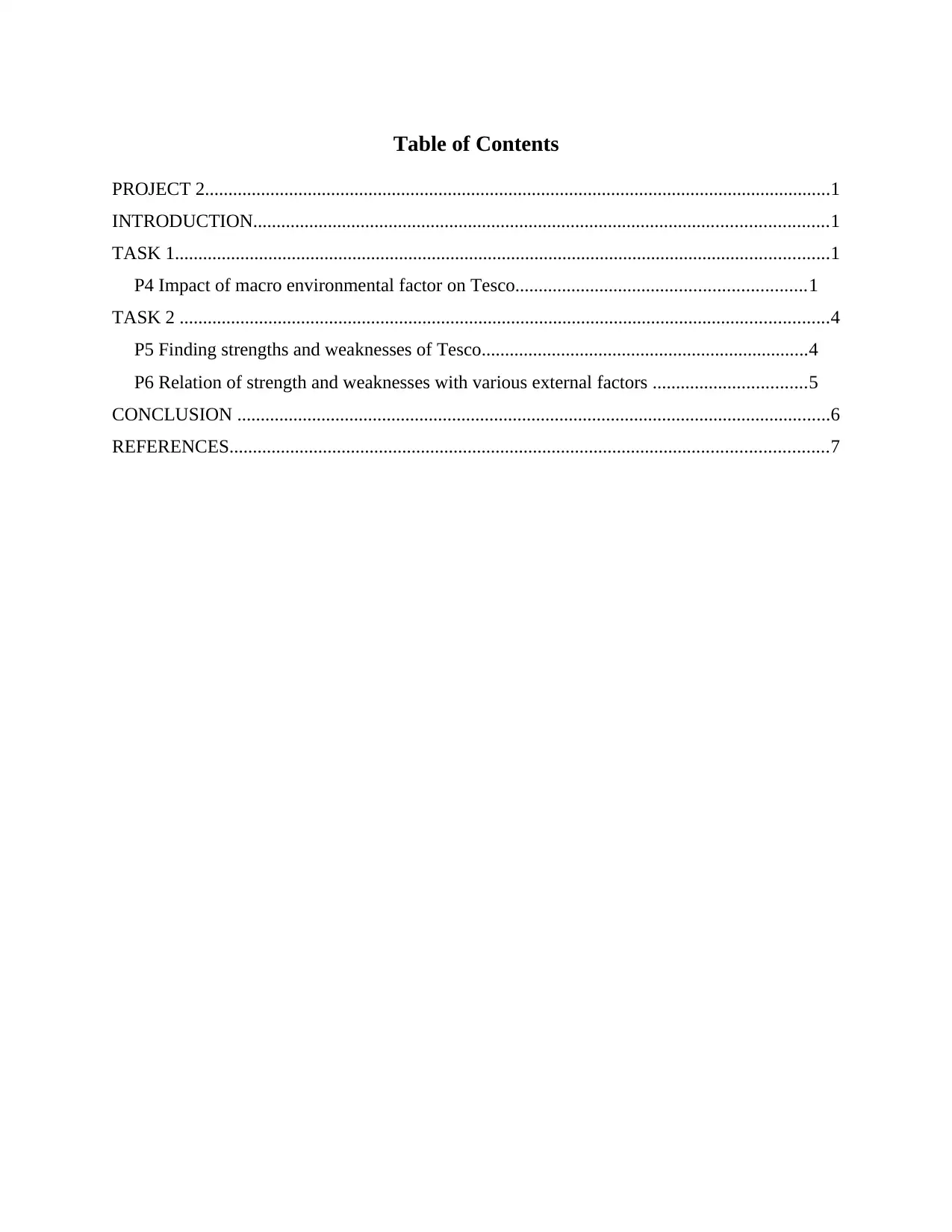
Table of Contents
PROJECT 2......................................................................................................................................1
INTRODUCTION...........................................................................................................................1
TASK 1............................................................................................................................................1
P4 Impact of macro environmental factor on Tesco..............................................................1
TASK 2 ...........................................................................................................................................4
P5 Finding strengths and weaknesses of Tesco......................................................................4
P6 Relation of strength and weaknesses with various external factors .................................5
CONCLUSION ...............................................................................................................................6
REFERENCES................................................................................................................................7
PROJECT 2......................................................................................................................................1
INTRODUCTION...........................................................................................................................1
TASK 1............................................................................................................................................1
P4 Impact of macro environmental factor on Tesco..............................................................1
TASK 2 ...........................................................................................................................................4
P5 Finding strengths and weaknesses of Tesco......................................................................4
P6 Relation of strength and weaknesses with various external factors .................................5
CONCLUSION ...............................................................................................................................6
REFERENCES................................................................................................................................7

⊘ This is a preview!⊘
Do you want full access?
Subscribe today to unlock all pages.

Trusted by 1+ million students worldwide
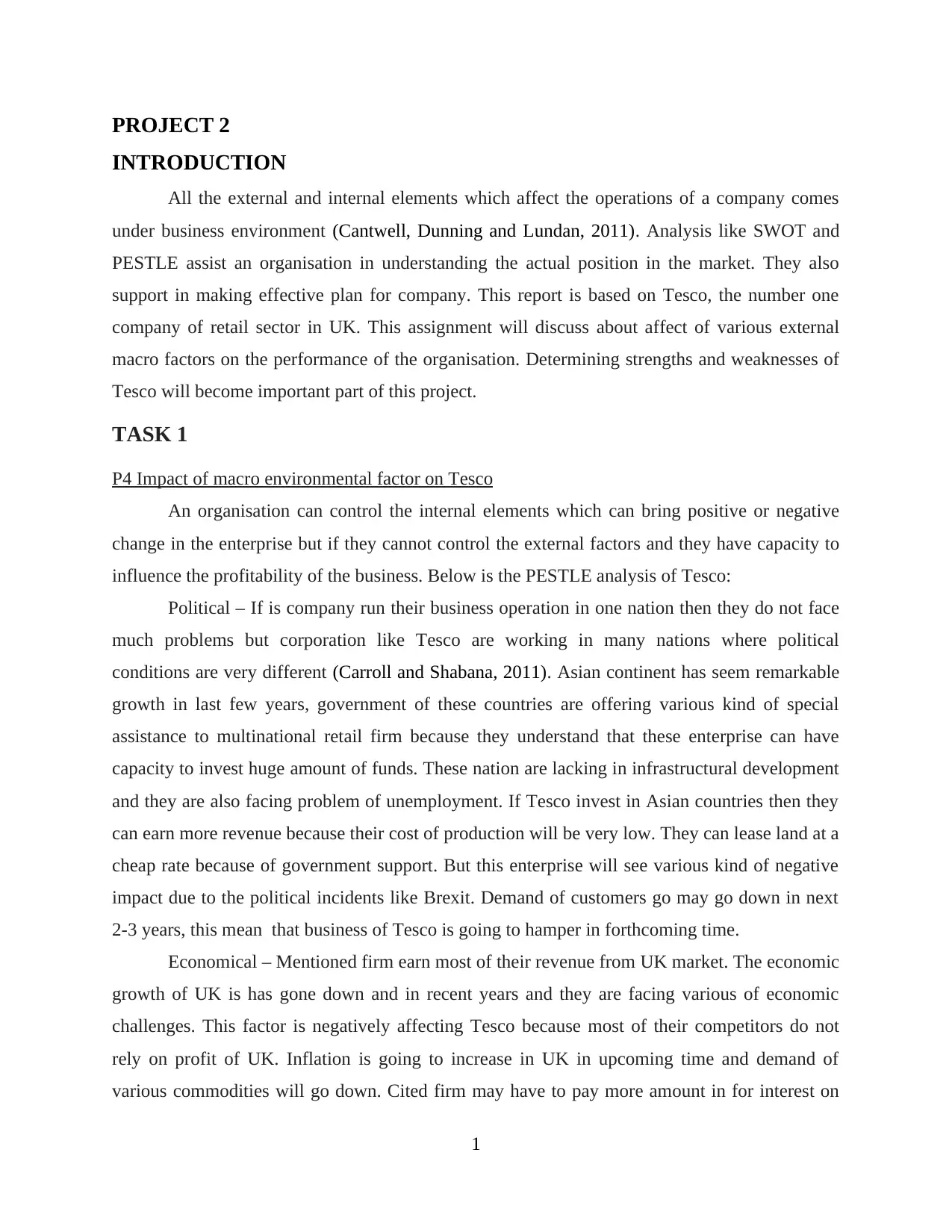
PROJECT 2
INTRODUCTION
All the external and internal elements which affect the operations of a company comes
under business environment (Cantwell, Dunning and Lundan, 2011). Analysis like SWOT and
PESTLE assist an organisation in understanding the actual position in the market. They also
support in making effective plan for company. This report is based on Tesco, the number one
company of retail sector in UK. This assignment will discuss about affect of various external
macro factors on the performance of the organisation. Determining strengths and weaknesses of
Tesco will become important part of this project.
TASK 1
P4 Impact of macro environmental factor on Tesco
An organisation can control the internal elements which can bring positive or negative
change in the enterprise but if they cannot control the external factors and they have capacity to
influence the profitability of the business. Below is the PESTLE analysis of Tesco:
Political – If is company run their business operation in one nation then they do not face
much problems but corporation like Tesco are working in many nations where political
conditions are very different (Carroll and Shabana, 2011). Asian continent has seem remarkable
growth in last few years, government of these countries are offering various kind of special
assistance to multinational retail firm because they understand that these enterprise can have
capacity to invest huge amount of funds. These nation are lacking in infrastructural development
and they are also facing problem of unemployment. If Tesco invest in Asian countries then they
can earn more revenue because their cost of production will be very low. They can lease land at a
cheap rate because of government support. But this enterprise will see various kind of negative
impact due to the political incidents like Brexit. Demand of customers go may go down in next
2-3 years, this mean that business of Tesco is going to hamper in forthcoming time.
Economical – Mentioned firm earn most of their revenue from UK market. The economic
growth of UK is has gone down and in recent years and they are facing various of economic
challenges. This factor is negatively affecting Tesco because most of their competitors do not
rely on profit of UK. Inflation is going to increase in UK in upcoming time and demand of
various commodities will go down. Cited firm may have to pay more amount in for interest on
1
INTRODUCTION
All the external and internal elements which affect the operations of a company comes
under business environment (Cantwell, Dunning and Lundan, 2011). Analysis like SWOT and
PESTLE assist an organisation in understanding the actual position in the market. They also
support in making effective plan for company. This report is based on Tesco, the number one
company of retail sector in UK. This assignment will discuss about affect of various external
macro factors on the performance of the organisation. Determining strengths and weaknesses of
Tesco will become important part of this project.
TASK 1
P4 Impact of macro environmental factor on Tesco
An organisation can control the internal elements which can bring positive or negative
change in the enterprise but if they cannot control the external factors and they have capacity to
influence the profitability of the business. Below is the PESTLE analysis of Tesco:
Political – If is company run their business operation in one nation then they do not face
much problems but corporation like Tesco are working in many nations where political
conditions are very different (Carroll and Shabana, 2011). Asian continent has seem remarkable
growth in last few years, government of these countries are offering various kind of special
assistance to multinational retail firm because they understand that these enterprise can have
capacity to invest huge amount of funds. These nation are lacking in infrastructural development
and they are also facing problem of unemployment. If Tesco invest in Asian countries then they
can earn more revenue because their cost of production will be very low. They can lease land at a
cheap rate because of government support. But this enterprise will see various kind of negative
impact due to the political incidents like Brexit. Demand of customers go may go down in next
2-3 years, this mean that business of Tesco is going to hamper in forthcoming time.
Economical – Mentioned firm earn most of their revenue from UK market. The economic
growth of UK is has gone down and in recent years and they are facing various of economic
challenges. This factor is negatively affecting Tesco because most of their competitors do not
rely on profit of UK. Inflation is going to increase in UK in upcoming time and demand of
various commodities will go down. Cited firm may have to pay more amount in for interest on
1
Paraphrase This Document
Need a fresh take? Get an instant paraphrase of this document with our AI Paraphraser
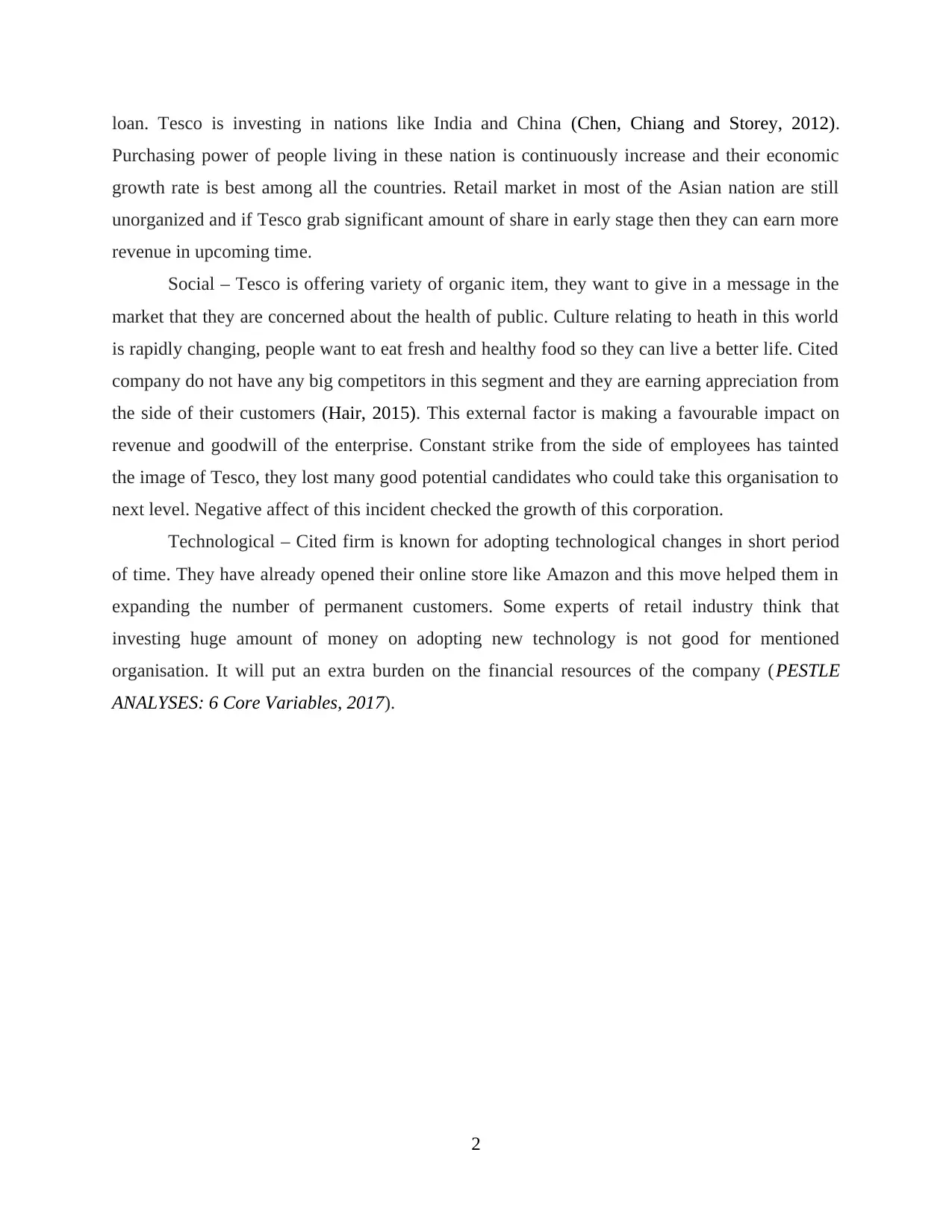
loan. Tesco is investing in nations like India and China (Chen, Chiang and Storey, 2012).
Purchasing power of people living in these nation is continuously increase and their economic
growth rate is best among all the countries. Retail market in most of the Asian nation are still
unorganized and if Tesco grab significant amount of share in early stage then they can earn more
revenue in upcoming time.
Social – Tesco is offering variety of organic item, they want to give in a message in the
market that they are concerned about the health of public. Culture relating to heath in this world
is rapidly changing, people want to eat fresh and healthy food so they can live a better life. Cited
company do not have any big competitors in this segment and they are earning appreciation from
the side of their customers (Hair, 2015). This external factor is making a favourable impact on
revenue and goodwill of the enterprise. Constant strike from the side of employees has tainted
the image of Tesco, they lost many good potential candidates who could take this organisation to
next level. Negative affect of this incident checked the growth of this corporation.
Technological – Cited firm is known for adopting technological changes in short period
of time. They have already opened their online store like Amazon and this move helped them in
expanding the number of permanent customers. Some experts of retail industry think that
investing huge amount of money on adopting new technology is not good for mentioned
organisation. It will put an extra burden on the financial resources of the company (PESTLE
ANALYSES: 6 Core Variables, 2017).
2
Purchasing power of people living in these nation is continuously increase and their economic
growth rate is best among all the countries. Retail market in most of the Asian nation are still
unorganized and if Tesco grab significant amount of share in early stage then they can earn more
revenue in upcoming time.
Social – Tesco is offering variety of organic item, they want to give in a message in the
market that they are concerned about the health of public. Culture relating to heath in this world
is rapidly changing, people want to eat fresh and healthy food so they can live a better life. Cited
company do not have any big competitors in this segment and they are earning appreciation from
the side of their customers (Hair, 2015). This external factor is making a favourable impact on
revenue and goodwill of the enterprise. Constant strike from the side of employees has tainted
the image of Tesco, they lost many good potential candidates who could take this organisation to
next level. Negative affect of this incident checked the growth of this corporation.
Technological – Cited firm is known for adopting technological changes in short period
of time. They have already opened their online store like Amazon and this move helped them in
expanding the number of permanent customers. Some experts of retail industry think that
investing huge amount of money on adopting new technology is not good for mentioned
organisation. It will put an extra burden on the financial resources of the company (PESTLE
ANALYSES: 6 Core Variables, 2017).
2
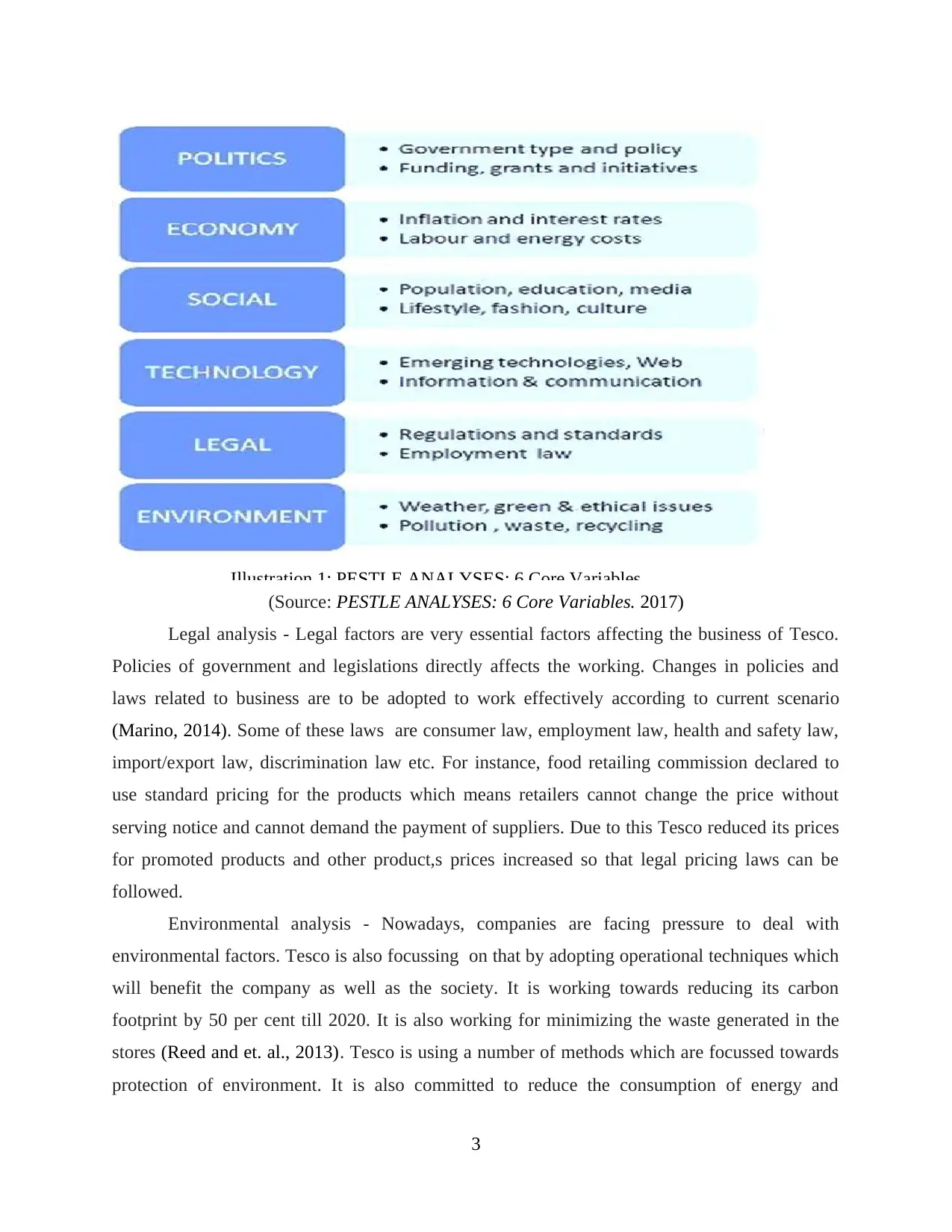
Illustration 1: PESTLE ANALYSES: 6 Core Variables.
(Source: PESTLE ANALYSES: 6 Core Variables. 2017)
Legal analysis - Legal factors are very essential factors affecting the business of Tesco.
Policies of government and legislations directly affects the working. Changes in policies and
laws related to business are to be adopted to work effectively according to current scenario
(Marino, 2014). Some of these laws are consumer law, employment law, health and safety law,
import/export law, discrimination law etc. For instance, food retailing commission declared to
use standard pricing for the products which means retailers cannot change the price without
serving notice and cannot demand the payment of suppliers. Due to this Tesco reduced its prices
for promoted products and other product,s prices increased so that legal pricing laws can be
followed.
Environmental analysis - Nowadays, companies are facing pressure to deal with
environmental factors. Tesco is also focussing on that by adopting operational techniques which
will benefit the company as well as the society. It is working towards reducing its carbon
footprint by 50 per cent till 2020. It is also working for minimizing the waste generated in the
stores (Reed and et. al., 2013). Tesco is using a number of methods which are focussed towards
protection of environment. It is also committed to reduce the consumption of energy and
3
(Source: PESTLE ANALYSES: 6 Core Variables. 2017)
Legal analysis - Legal factors are very essential factors affecting the business of Tesco.
Policies of government and legislations directly affects the working. Changes in policies and
laws related to business are to be adopted to work effectively according to current scenario
(Marino, 2014). Some of these laws are consumer law, employment law, health and safety law,
import/export law, discrimination law etc. For instance, food retailing commission declared to
use standard pricing for the products which means retailers cannot change the price without
serving notice and cannot demand the payment of suppliers. Due to this Tesco reduced its prices
for promoted products and other product,s prices increased so that legal pricing laws can be
followed.
Environmental analysis - Nowadays, companies are facing pressure to deal with
environmental factors. Tesco is also focussing on that by adopting operational techniques which
will benefit the company as well as the society. It is working towards reducing its carbon
footprint by 50 per cent till 2020. It is also working for minimizing the waste generated in the
stores (Reed and et. al., 2013). Tesco is using a number of methods which are focussed towards
protection of environment. It is also committed to reduce the consumption of energy and
3
⊘ This is a preview!⊘
Do you want full access?
Subscribe today to unlock all pages.

Trusted by 1+ million students worldwide
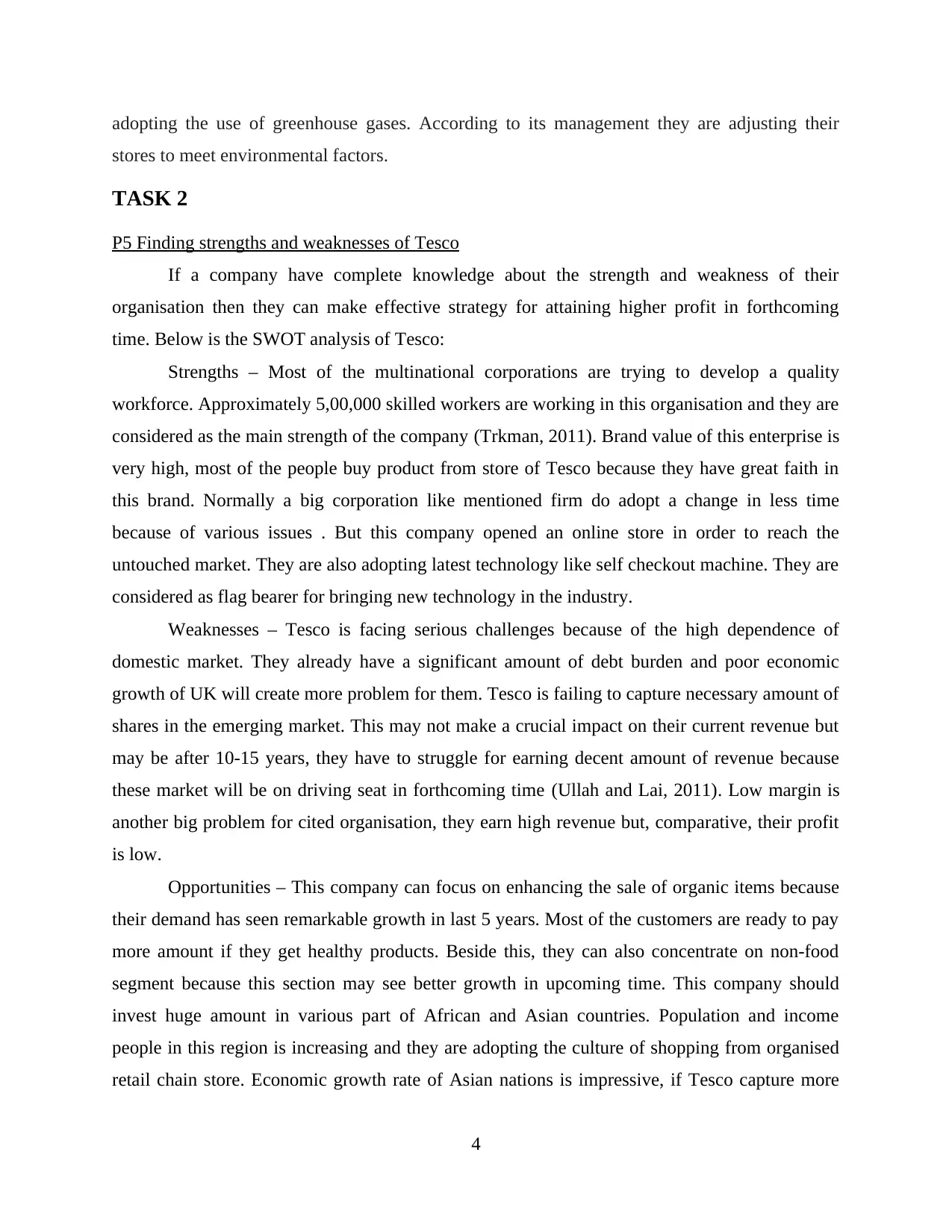
adopting the use of greenhouse gases. According to its management they are adjusting their
stores to meet environmental factors.
TASK 2
P5 Finding strengths and weaknesses of Tesco
If a company have complete knowledge about the strength and weakness of their
organisation then they can make effective strategy for attaining higher profit in forthcoming
time. Below is the SWOT analysis of Tesco:
Strengths – Most of the multinational corporations are trying to develop a quality
workforce. Approximately 5,00,000 skilled workers are working in this organisation and they are
considered as the main strength of the company (Trkman, 2011). Brand value of this enterprise is
very high, most of the people buy product from store of Tesco because they have great faith in
this brand. Normally a big corporation like mentioned firm do adopt a change in less time
because of various issues . But this company opened an online store in order to reach the
untouched market. They are also adopting latest technology like self checkout machine. They are
considered as flag bearer for bringing new technology in the industry.
Weaknesses – Tesco is facing serious challenges because of the high dependence of
domestic market. They already have a significant amount of debt burden and poor economic
growth of UK will create more problem for them. Tesco is failing to capture necessary amount of
shares in the emerging market. This may not make a crucial impact on their current revenue but
may be after 10-15 years, they have to struggle for earning decent amount of revenue because
these market will be on driving seat in forthcoming time (Ullah and Lai, 2011). Low margin is
another big problem for cited organisation, they earn high revenue but, comparative, their profit
is low.
Opportunities – This company can focus on enhancing the sale of organic items because
their demand has seen remarkable growth in last 5 years. Most of the customers are ready to pay
more amount if they get healthy products. Beside this, they can also concentrate on non-food
segment because this section may see better growth in upcoming time. This company should
invest huge amount in various part of African and Asian countries. Population and income
people in this region is increasing and they are adopting the culture of shopping from organised
retail chain store. Economic growth rate of Asian nations is impressive, if Tesco capture more
4
stores to meet environmental factors.
TASK 2
P5 Finding strengths and weaknesses of Tesco
If a company have complete knowledge about the strength and weakness of their
organisation then they can make effective strategy for attaining higher profit in forthcoming
time. Below is the SWOT analysis of Tesco:
Strengths – Most of the multinational corporations are trying to develop a quality
workforce. Approximately 5,00,000 skilled workers are working in this organisation and they are
considered as the main strength of the company (Trkman, 2011). Brand value of this enterprise is
very high, most of the people buy product from store of Tesco because they have great faith in
this brand. Normally a big corporation like mentioned firm do adopt a change in less time
because of various issues . But this company opened an online store in order to reach the
untouched market. They are also adopting latest technology like self checkout machine. They are
considered as flag bearer for bringing new technology in the industry.
Weaknesses – Tesco is facing serious challenges because of the high dependence of
domestic market. They already have a significant amount of debt burden and poor economic
growth of UK will create more problem for them. Tesco is failing to capture necessary amount of
shares in the emerging market. This may not make a crucial impact on their current revenue but
may be after 10-15 years, they have to struggle for earning decent amount of revenue because
these market will be on driving seat in forthcoming time (Ullah and Lai, 2011). Low margin is
another big problem for cited organisation, they earn high revenue but, comparative, their profit
is low.
Opportunities – This company can focus on enhancing the sale of organic items because
their demand has seen remarkable growth in last 5 years. Most of the customers are ready to pay
more amount if they get healthy products. Beside this, they can also concentrate on non-food
segment because this section may see better growth in upcoming time. This company should
invest huge amount in various part of African and Asian countries. Population and income
people in this region is increasing and they are adopting the culture of shopping from organised
retail chain store. Economic growth rate of Asian nations is impressive, if Tesco capture more
4
Paraphrase This Document
Need a fresh take? Get an instant paraphrase of this document with our AI Paraphraser
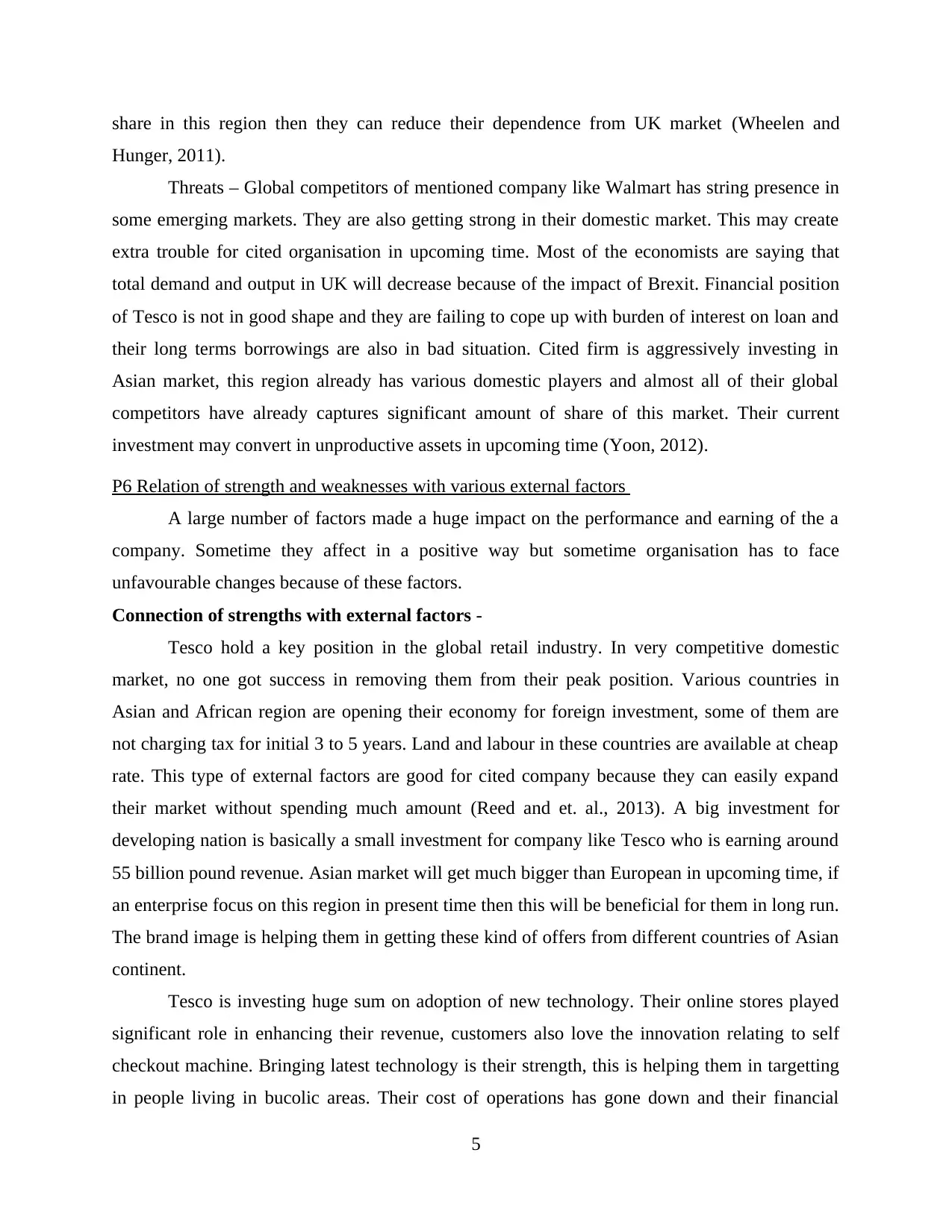
share in this region then they can reduce their dependence from UK market (Wheelen and
Hunger, 2011).
Threats – Global competitors of mentioned company like Walmart has string presence in
some emerging markets. They are also getting strong in their domestic market. This may create
extra trouble for cited organisation in upcoming time. Most of the economists are saying that
total demand and output in UK will decrease because of the impact of Brexit. Financial position
of Tesco is not in good shape and they are failing to cope up with burden of interest on loan and
their long terms borrowings are also in bad situation. Cited firm is aggressively investing in
Asian market, this region already has various domestic players and almost all of their global
competitors have already captures significant amount of share of this market. Their current
investment may convert in unproductive assets in upcoming time (Yoon, 2012).
P6 Relation of strength and weaknesses with various external factors
A large number of factors made a huge impact on the performance and earning of the a
company. Sometime they affect in a positive way but sometime organisation has to face
unfavourable changes because of these factors.
Connection of strengths with external factors -
Tesco hold a key position in the global retail industry. In very competitive domestic
market, no one got success in removing them from their peak position. Various countries in
Asian and African region are opening their economy for foreign investment, some of them are
not charging tax for initial 3 to 5 years. Land and labour in these countries are available at cheap
rate. This type of external factors are good for cited company because they can easily expand
their market without spending much amount (Reed and et. al., 2013). A big investment for
developing nation is basically a small investment for company like Tesco who is earning around
55 billion pound revenue. Asian market will get much bigger than European in upcoming time, if
an enterprise focus on this region in present time then this will be beneficial for them in long run.
The brand image is helping them in getting these kind of offers from different countries of Asian
continent.
Tesco is investing huge sum on adoption of new technology. Their online stores played
significant role in enhancing their revenue, customers also love the innovation relating to self
checkout machine. Bringing latest technology is their strength, this is helping them in targetting
in people living in bucolic areas. Their cost of operations has gone down and their financial
5
Hunger, 2011).
Threats – Global competitors of mentioned company like Walmart has string presence in
some emerging markets. They are also getting strong in their domestic market. This may create
extra trouble for cited organisation in upcoming time. Most of the economists are saying that
total demand and output in UK will decrease because of the impact of Brexit. Financial position
of Tesco is not in good shape and they are failing to cope up with burden of interest on loan and
their long terms borrowings are also in bad situation. Cited firm is aggressively investing in
Asian market, this region already has various domestic players and almost all of their global
competitors have already captures significant amount of share of this market. Their current
investment may convert in unproductive assets in upcoming time (Yoon, 2012).
P6 Relation of strength and weaknesses with various external factors
A large number of factors made a huge impact on the performance and earning of the a
company. Sometime they affect in a positive way but sometime organisation has to face
unfavourable changes because of these factors.
Connection of strengths with external factors -
Tesco hold a key position in the global retail industry. In very competitive domestic
market, no one got success in removing them from their peak position. Various countries in
Asian and African region are opening their economy for foreign investment, some of them are
not charging tax for initial 3 to 5 years. Land and labour in these countries are available at cheap
rate. This type of external factors are good for cited company because they can easily expand
their market without spending much amount (Reed and et. al., 2013). A big investment for
developing nation is basically a small investment for company like Tesco who is earning around
55 billion pound revenue. Asian market will get much bigger than European in upcoming time, if
an enterprise focus on this region in present time then this will be beneficial for them in long run.
The brand image is helping them in getting these kind of offers from different countries of Asian
continent.
Tesco is investing huge sum on adoption of new technology. Their online stores played
significant role in enhancing their revenue, customers also love the innovation relating to self
checkout machine. Bringing latest technology is their strength, this is helping them in targetting
in people living in bucolic areas. Their cost of operations has gone down and their financial
5
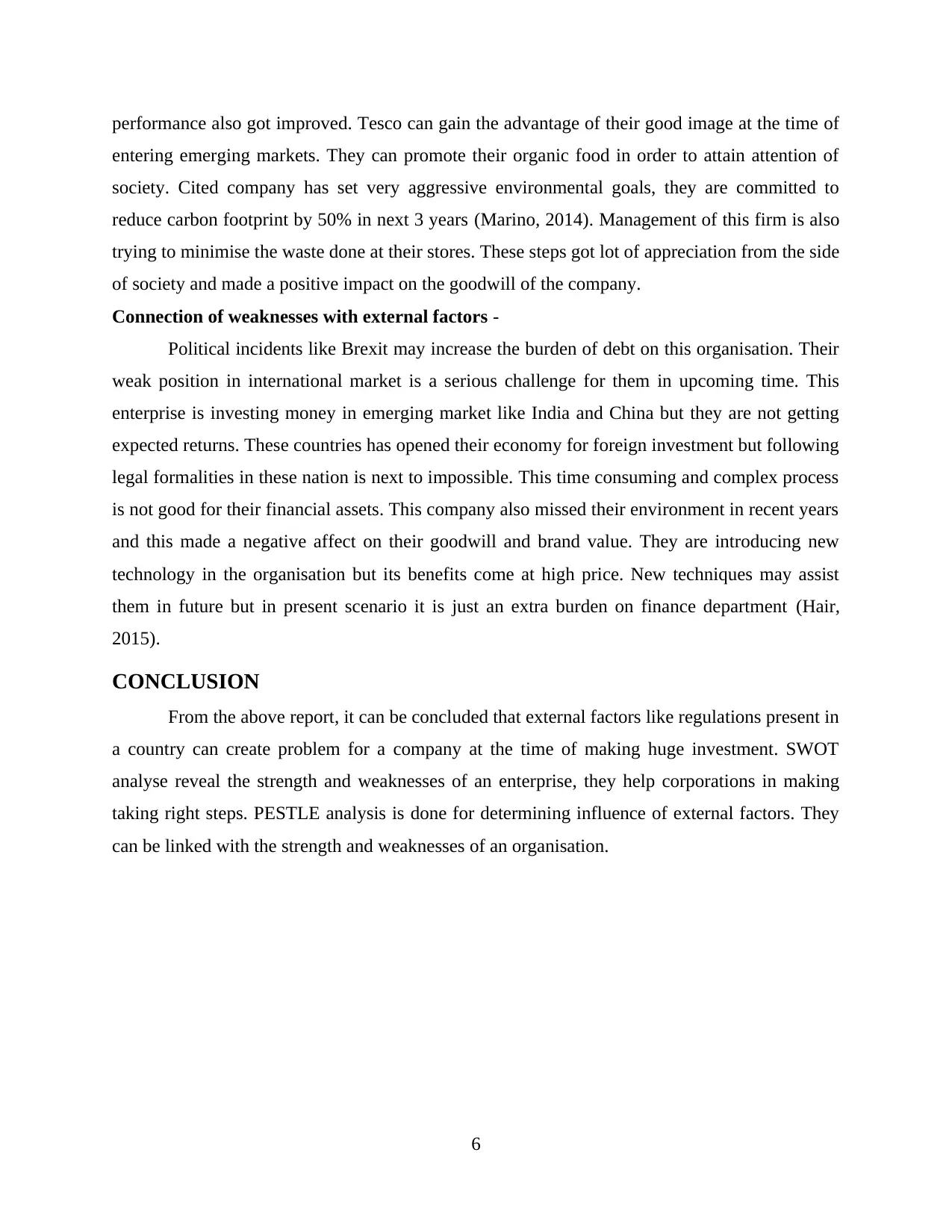
performance also got improved. Tesco can gain the advantage of their good image at the time of
entering emerging markets. They can promote their organic food in order to attain attention of
society. Cited company has set very aggressive environmental goals, they are committed to
reduce carbon footprint by 50% in next 3 years (Marino, 2014). Management of this firm is also
trying to minimise the waste done at their stores. These steps got lot of appreciation from the side
of society and made a positive impact on the goodwill of the company.
Connection of weaknesses with external factors -
Political incidents like Brexit may increase the burden of debt on this organisation. Their
weak position in international market is a serious challenge for them in upcoming time. This
enterprise is investing money in emerging market like India and China but they are not getting
expected returns. These countries has opened their economy for foreign investment but following
legal formalities in these nation is next to impossible. This time consuming and complex process
is not good for their financial assets. This company also missed their environment in recent years
and this made a negative affect on their goodwill and brand value. They are introducing new
technology in the organisation but its benefits come at high price. New techniques may assist
them in future but in present scenario it is just an extra burden on finance department (Hair,
2015).
CONCLUSION
From the above report, it can be concluded that external factors like regulations present in
a country can create problem for a company at the time of making huge investment. SWOT
analyse reveal the strength and weaknesses of an enterprise, they help corporations in making
taking right steps. PESTLE analysis is done for determining influence of external factors. They
can be linked with the strength and weaknesses of an organisation.
6
entering emerging markets. They can promote their organic food in order to attain attention of
society. Cited company has set very aggressive environmental goals, they are committed to
reduce carbon footprint by 50% in next 3 years (Marino, 2014). Management of this firm is also
trying to minimise the waste done at their stores. These steps got lot of appreciation from the side
of society and made a positive impact on the goodwill of the company.
Connection of weaknesses with external factors -
Political incidents like Brexit may increase the burden of debt on this organisation. Their
weak position in international market is a serious challenge for them in upcoming time. This
enterprise is investing money in emerging market like India and China but they are not getting
expected returns. These countries has opened their economy for foreign investment but following
legal formalities in these nation is next to impossible. This time consuming and complex process
is not good for their financial assets. This company also missed their environment in recent years
and this made a negative affect on their goodwill and brand value. They are introducing new
technology in the organisation but its benefits come at high price. New techniques may assist
them in future but in present scenario it is just an extra burden on finance department (Hair,
2015).
CONCLUSION
From the above report, it can be concluded that external factors like regulations present in
a country can create problem for a company at the time of making huge investment. SWOT
analyse reveal the strength and weaknesses of an enterprise, they help corporations in making
taking right steps. PESTLE analysis is done for determining influence of external factors. They
can be linked with the strength and weaknesses of an organisation.
6
⊘ This is a preview!⊘
Do you want full access?
Subscribe today to unlock all pages.

Trusted by 1+ million students worldwide
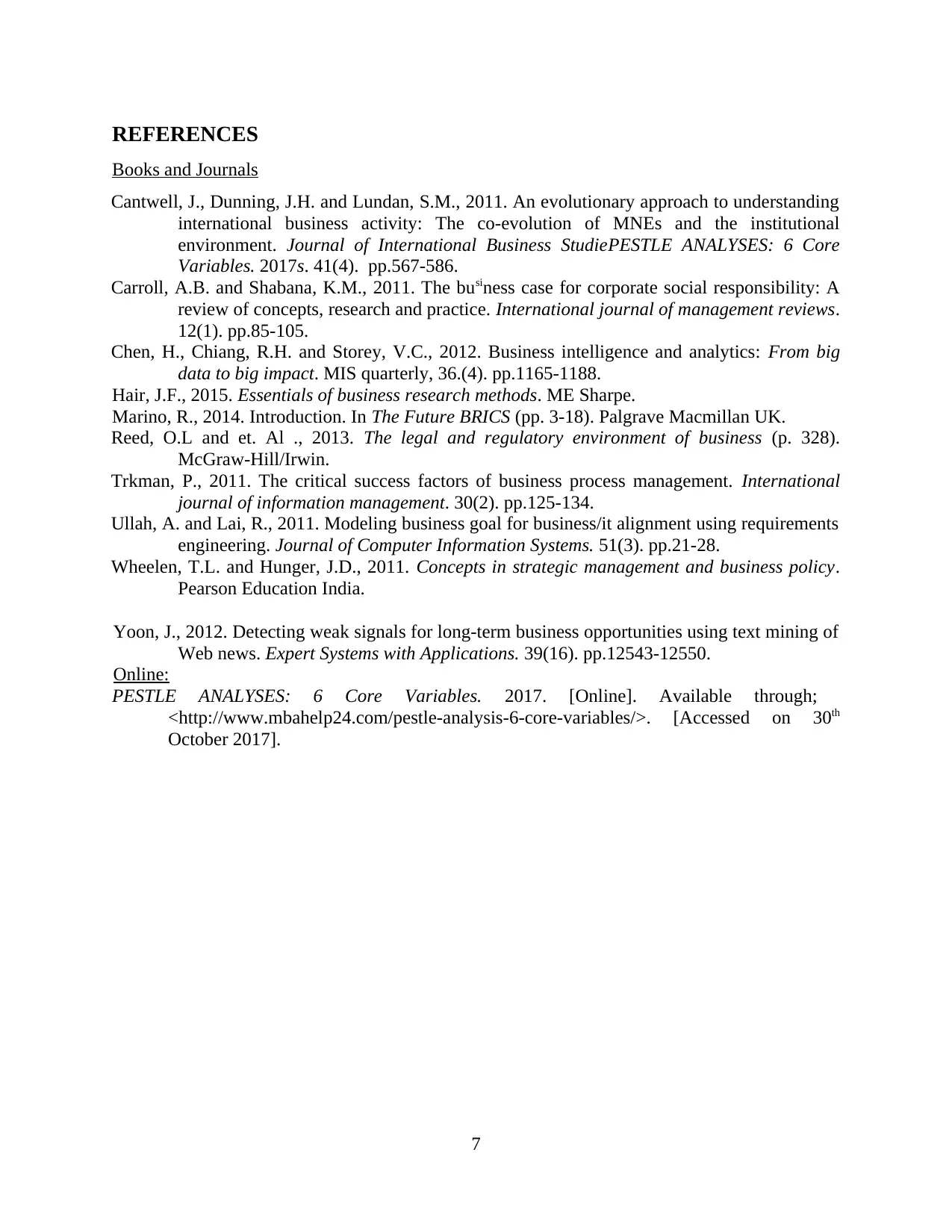
REFERENCES
Books and Journals
Cantwell, J., Dunning, J.H. and Lundan, S.M., 2011. An evolutionary approach to understanding
international business activity: The co-evolution of MNEs and the institutional
environment. Journal of International Business StudiePESTLE ANALYSES: 6 Core
Variables. 2017s. 41(4). pp.567-586.
Carroll, A.B. and Shabana, K.M., 2011. The business case for corporate social responsibility: A
review of concepts, research and practice. International journal of management reviews.
12(1). pp.85-105.
Chen, H., Chiang, R.H. and Storey, V.C., 2012. Business intelligence and analytics: From big
data to big impact. MIS quarterly, 36.(4). pp.1165-1188.
Hair, J.F., 2015. Essentials of business research methods. ME Sharpe.
Marino, R., 2014. Introduction. In The Future BRICS (pp. 3-18). Palgrave Macmillan UK.
Reed, O.L and et. Al ., 2013. The legal and regulatory environment of business (p. 328).
McGraw-Hill/Irwin.
Trkman, P., 2011. The critical success factors of business process management. International
journal of information management. 30(2). pp.125-134.
Ullah, A. and Lai, R., 2011. Modeling business goal for business/it alignment using requirements
engineering. Journal of Computer Information Systems. 51(3). pp.21-28.
Wheelen, T.L. and Hunger, J.D., 2011. Concepts in strategic management and business policy.
Pearson Education India.
Yoon, J., 2012. Detecting weak signals for long-term business opportunities using text mining of
Web news. Expert Systems with Applications. 39(16). pp.12543-12550.
Online:
PESTLE ANALYSES: 6 Core Variables. 2017. [Online]. Available through;
<http://www.mbahelp24.com/pestle-analysis-6-core-variables/>. [Accessed on 30th
October 2017].
7
Books and Journals
Cantwell, J., Dunning, J.H. and Lundan, S.M., 2011. An evolutionary approach to understanding
international business activity: The co-evolution of MNEs and the institutional
environment. Journal of International Business StudiePESTLE ANALYSES: 6 Core
Variables. 2017s. 41(4). pp.567-586.
Carroll, A.B. and Shabana, K.M., 2011. The business case for corporate social responsibility: A
review of concepts, research and practice. International journal of management reviews.
12(1). pp.85-105.
Chen, H., Chiang, R.H. and Storey, V.C., 2012. Business intelligence and analytics: From big
data to big impact. MIS quarterly, 36.(4). pp.1165-1188.
Hair, J.F., 2015. Essentials of business research methods. ME Sharpe.
Marino, R., 2014. Introduction. In The Future BRICS (pp. 3-18). Palgrave Macmillan UK.
Reed, O.L and et. Al ., 2013. The legal and regulatory environment of business (p. 328).
McGraw-Hill/Irwin.
Trkman, P., 2011. The critical success factors of business process management. International
journal of information management. 30(2). pp.125-134.
Ullah, A. and Lai, R., 2011. Modeling business goal for business/it alignment using requirements
engineering. Journal of Computer Information Systems. 51(3). pp.21-28.
Wheelen, T.L. and Hunger, J.D., 2011. Concepts in strategic management and business policy.
Pearson Education India.
Yoon, J., 2012. Detecting weak signals for long-term business opportunities using text mining of
Web news. Expert Systems with Applications. 39(16). pp.12543-12550.
Online:
PESTLE ANALYSES: 6 Core Variables. 2017. [Online]. Available through;
<http://www.mbahelp24.com/pestle-analysis-6-core-variables/>. [Accessed on 30th
October 2017].
7
1 out of 10
Related Documents
Your All-in-One AI-Powered Toolkit for Academic Success.
+13062052269
info@desklib.com
Available 24*7 on WhatsApp / Email
![[object Object]](/_next/static/media/star-bottom.7253800d.svg)
Unlock your academic potential
Copyright © 2020–2025 A2Z Services. All Rights Reserved. Developed and managed by ZUCOL.





